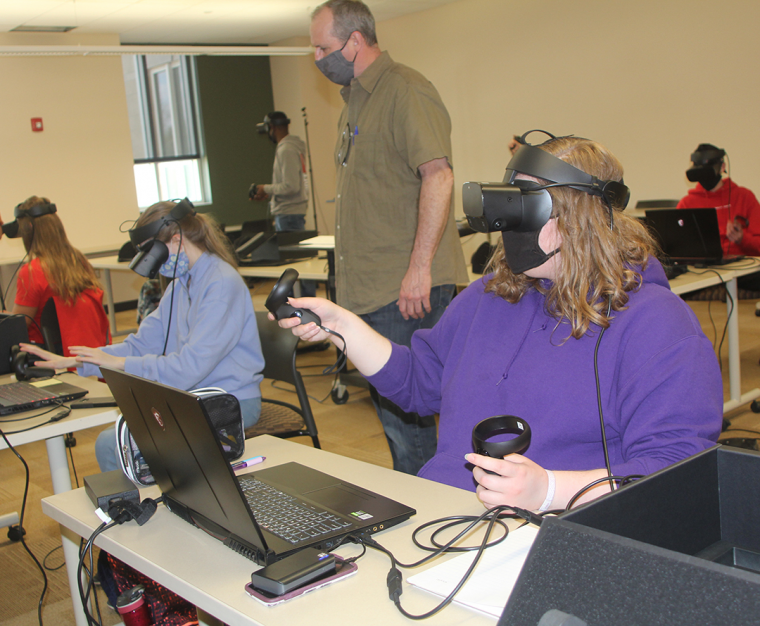
MONMOUTH, ILLINOIS (May 12, 2021) — For professors and students who are more than ready to move on from classes that have anything to do with the phrase "virtual learning," Monmouth College chemistry professor Brad Sturgeon and some of his colleagues in the Center for Science and Business might say, "Not so fast."
On April 22, Sturgeon put to use for the first time the College's eight new sets of virtual-reality equipment. The laptop and Oculus Rift S headset systems, which are portable, join three other "fixed" VR systems in the CSB, which have been used by kinesiology instructor Jen Braun and biology professor Kevin Baldwin to help teach anatomy.
"Instructional Technology Manager Kyle Martin was integral in system evaluation, acquisition, and set-up," said Sturgeon. "We could not have done all this without him."
On the day they debuted, Sturgeon put the systems in the hands of some of his senior students, before using them the following week with one of his introductory classes. The goal, he said, is to have the new VR systems ready to use next fall for his general-chemistry and quantum-mechanics courses.
Hands-on learning, virtually
"It really does bring it to life," said Sturgeon of the molecular visualization that students can experience using the systems, which were acquired through a crowdfunding initiative. "The molecule just floats right in front of you."
After strapping on a headset and controllers for each hand, students can virtually take hold of a given molecule, enlarging or shrinking it as they see fit, and rotating it in any direction to better observe a part of the molecule they wish to examine.
"Once I learn how to do it myself, I could enter a 'room' with seven other students, and I could hold a molecule, and then I could literally pass it to them and they could take over," said Sturgeon. "You can also modify the chemical structure. We have to visualize molecules with these sorts of tools, because the molecules are too small to examine with a microscope."
Outside of the sciences, Sturgeon said the new VR systems might be used for some of the College's Global Perspectives courses.
"In the future, I hope that the equipment can be used to explore 'global perspectives' using the Google Earth VR software that can take you anywhere in the world," he said. "Just type in an address, and it takes you there immediately," even by flying, once users get acclimated to the hand controls.
In fact, Sturgeon uses the Google Earth software as a way to get his chemistry students used to working in virtual reality.
"You really learn how to use the hand controls," he said. "It gets the students more comfortable as they prepare to work with molecular models."
Of course, today's generation of students has quite a head start when it comes to working with such technology.
"They pick things up a lot faster, and they're very willing to jump in and do it," said Sturgeon. "The majority of my students so far have been extremely savvy with the equipment and know how to navigate it."
Studying the human body
Baldwin spoke about bringing the first set of VR equipment to campus a few years ago.
"It's the way things are starting to head," he said. "Medical schools are using this. I got excited about VR when I went to a conference and a professor at a medical school used it, and I was like 'Wow, this is a lot better than it used to be. This is pretty amazing.' I figured, if I got excited about it, students are probably going to get pretty excited about it."
Hannah McVey ('21), an exercise science major from Monmouth, enjoys the new perspective provided by VR.
"It gives you a different perspective," she said. "You can go inside the heart and look around. With each pump, you can see the valves moving. You can peel different layers off the heart and see all the different layers and the valves and each chamber."
Braun and Baldwin said VR complements the other ways that students learn.
"If they see it on paper, if they see it in an anatomy and physiology lab and if they see it on a screen, it's just allowing them to have that much more an opportunity to make it stick in their head," said Braun.
"We have our real specimens — bones, cadavers — that they can learn on, but this is a way of supplementing that and giving them another avenue to access the material," said Baldwin.










